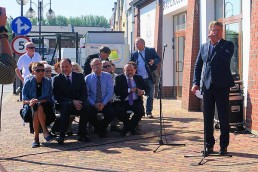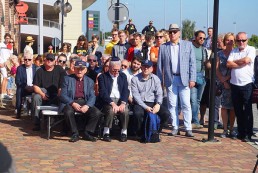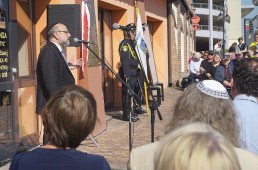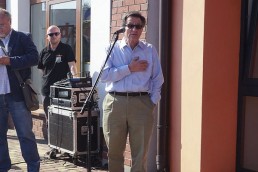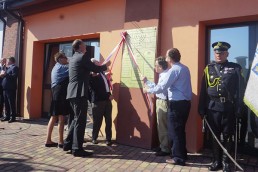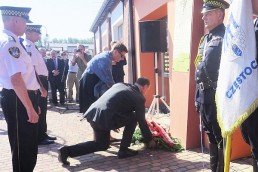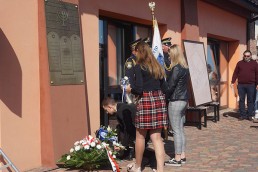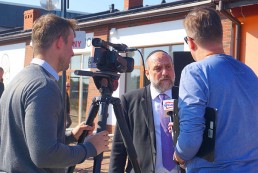Plaque Unveiled on HASAG-Warta Site
Words: Alan Silberstein Photos: Asia Fanaberia Sidorowicz
On 12th September 2019, about 20 participants in a Shabbaton, held in Piotrków Trybunalski the previous week, visited Czestochowa, where many also had roots. In particular, many Jews from Piotrków Trybunalski who survived the Holocaust, survived because, in November 1944, they were taken to work as slave labourers in Częstochowa, after the labour camps, where they had previously worked, were liquidated. Those, who were not taken to work in Częstochowa, were sent to Buchenwald. Many worked in the HASAG-Warta armaments factory, one of four HASAG slave labour camps in Częstochowa.
The Shabbaton participants were invited, by the Częstochowa TSKŻ and the World Society of Częstochowa Jews & Their Descendants, to visit important sites in Częstochowa including the Holocaust Memorial designed by Samuel Willenberg, the Jewish Museum, a branch of the Częstochowa Regionalal Museum and the site of the HASAG-Warta slave labour camp.
When it was realised that no sign existed which marked the location of the HASAG-Warta camp, where some 4,000 Jewish prisoners had worked from June 1943 to January 1945, we determined to correct that oversight before last week’s visit. The Director of the Częstochowa Regional Museum Tadeusz Piersiak approached Wojciech Kaczmarski, President of the real estate company Polaris, which had redeveloped the site. Mr. Kaczmarski readily agreed to mount a plaque memorialising the victims of Nazi persecution who had suffered and died at this location. Piotr Stasiak and Hana Eliana Gawronska, both of Warsaw, designed the plaque and Ryszard Welgryn, a leader of the Częstochowa Jewish community and the proprietor of ARTMEDAL, executed the design. All was done in record time so that the plaque could be dedicated last week!
The ceremony was MC’ed by Director Piersiak. Speakers included Częstochowa Deputy Mayor Andrzej Szewiński, Piotrków Trybunalski survivor Robert Dessau, former inmate of HASAG-Warta who was liberated in Częstochowa, Chief Rabbi of Poland, Michael Schudrich, Deputy Mayor Naor Yerushalmi of Ness Ziona, Israel (the sister city of Piotrkow Tribunalski) and World Society of Częstochowa Jews representative Alan Silberstein. The official unveiling was performed by Messrs. Szewinski, Dessau, Silberstein and Yerushalmi. Memorial candles and wreaths were placed by representatives of the City of Częstochowa and students from the Jacek Malczewski School of Fine Arts. Also in attendance were many local citizens and volunteers from Piotrków Trybunalski. Only two of the attendees were survivors themselves, Robert Dessau of the United States and Sir Ben Helfgott of the United Kingdom.
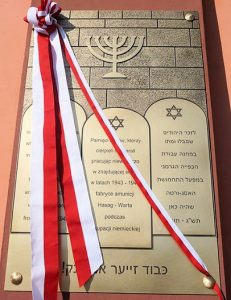 The beautiful brass plaque shows three matzevat- or tombstones- with the inscription in three languages, Polish, Hebrew and English:
The beautiful brass plaque shows three matzevat- or tombstones- with the inscription in three languages, Polish, Hebrew and English:
In memory of the Jews who suffered and died in the German forced labor camp in the Hasag-Warta ammunition factory which was here from 1943 to 1945.
At the bottom, in Yiddish, is the traditional memorial:
Koved zeier ondenk, (May Their Memory Be Honoured).
Behind the matzevot, is a representation of the Western Wall in Jerusalem and above, is a seven-candle menorah, the oldest symbol of the Jewish people. A similar plaque was dedicated at HASAG-Pelcery by the World Society some years ago.
Historical Background
HASAG, an acronym of Hugo Schneider AG, was a German metals goods manufacturer which received contracts to manufacture ammunition for the German war effort, using Jewish slave labour as well as Polish labour. HASAG converted four factories in Czestochowa for this purpose, which were named Pelcery (or Apparatexbau), Czestochwianka, Raków and Warta. The factory at Warta was built as a spinning mill by its Jewish founders in 1896. HASAG operated there from June 1943 through January 1945, employing some 4,000 Jewish prisoners over the period (about 2,000 at any one time). In November 1944, after the liquidation of the slave labour camps in Piotrków, several railcars taking Piotrków Jews to Buchenwald were separated in Częstochowa and about 1,000 Jews from Piotrków were sent to work in three of the HASAG camps, including HASAG-Warta. Days before the liberation of Częstochowa in January 1945, most survivors were taken east to camps like Buchenwald.
After the War, the Warta factory once again produced linen. Since the 1990’s, the site has since been redeveloped into commercial buildings located at ul. Krakowska 45.

